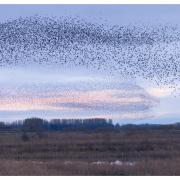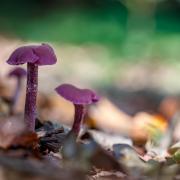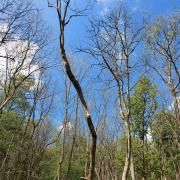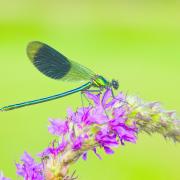Catherine Jones turned her back on a career in banking to spend time with Yorkshire’s bees.

For as long as I can remember, bumblebees, solitary bees and insects have fascinated me. They are not only fabulous to watch, but they also play and important role as pollinators of our wildflowers and crops.
I moved from a career in International Banking in the City of London to pursue a career in nature conservation and now work for Buglife on the Urban Buzz Leeds project. Having visited wildflower meadows, woodland glades, upland moorland and heathland in Yorkshire Wildlife Trust nature reserves, the Yorkshire Dales and North York Moors, I have seen the fabulous diversity of bee species that thrive in Yorkshire.
From the common carder bee (a bumblebee) I saw recently at Yorkshire Wildlife Trust’s Potteric Carr visiting viper’s bugloss, to the distinctive solitary Ashy mining bee seen at the Trust’s Broadhead Clough, bees can now be seen in large numbers across Yorkshire and foraging on wild flowering plants.
Many of the wild British bee species can be found in Yorkshire; the eight common bumblebee species, some of the less common bumblebee species and a large number of solitary bee species. Dandelions flowering along roadside verges are a fabulous place to look for solitary bees, and foxgloves, thistles and bramble along field margins or woodland glades are just perfect for bumblebees.
1. The buff-tailed bumblebee queen is large and impressive. She has a mustard-yellow band on her thorax, a mustard-yellow band on her abdomen and a buff coloured tail. However the workers have a white tail and are similar to white-tailed bumblebee workers
2. The white-tailed bumblebee is similar to the buff-tailed bumblebee, although she is slightly slimmer and has lemon-yellow bands and a white tail. As the workers of both buff-tailed and white-tailed workers have white tails, they cannot be separated in the field.
3. The red-tailed bumblebee, queen and workers are black with and red tail, although this can fade, or appear, orange in bright sunlight.
4. Despite its small size, the early bumblebee queen, emerges early in the spring and starts a small colony. She has a yellow band on her thorax and her abdomen, and a small orange tail.
5. The common carder bee, is completely brownish colour, and ‘cards’ moss and grass together to form a nest at the base of a clump of grass.
6. The garden bumblebee, has two yellow bands on the thorax, a yellow band on the abdomen, a white tail and a long face. The garden bumblebee is often found foraging on foxgloves, as the name suggests, in gardens.
7. The heath bumblebee, is a small bumblebee, often found on heathland foraging from heather, with a similar colour pattern to the garden bumblebee but with a short face.
8. The tree bumblebee, was first recorded in the south of England in 2001, but is now common across the British Isles, including Yorkshire. With its distinctive colour pattern (ginger thorax, black abdomen and white tail), the tree bumblebee can often be easily identified and is often found in urban habitats and gardens where they sometimes nest in holes in trees, bird boxes or the eaves of buildings.
9. The bilberry bumblebee, is a spectacular bumblebee and one of the less common found in Yorkshire.
Queens can be found foraging on bilberry in April and May, or on gorse, bramble and bell heather later in the year, at upland moorland and heathland areas in the South Pennines, the Yorkshire Dales and the North York Moors. She has a yellow band on her thorax and her abdomen, and a stunning large orange tail.
10. My first sighting of the solitary Ashy mining bee, with its distinctive black and grey furry thorax, in Yorkshire was at the Yorkshire Wildlife Trust nature reserve at Broadhead Clough. It was foraging on the wildflowers in the meadow.
However, my most memorable solitary bee sightings were on a visit to the fabulous grassland at YWT Townclose Hills, where I saw several bumblebee species and many solitary bee species.
Catherine’s top tip would be to visit a wildflower-rich meadow on a warm, dry, still day… Perhaps the meadow at Brockdale nature reserve when the sun is shining, the temperature is above 13oC and it is not too breezy, although even if it is breezy, you may still be able to find wild bees in sheltered spots foraging on the wildflowers.
How to attract bees to your garden, and look after them once they arrive
As a general guide, bees love daisy and bell shaped flowers. Always choose single flower varieties, double flowers don’t provide nectar for insects. The flowers on many fruit and vegetable crops are favourites of bees – beans, peas and fragrant herbs are loved, as are apples, currants and raspberries. If you have space around your vegetable plot, add flowers like azaleas, bluebells, forget-me-nots, foxgloves and lupins.
Also, think about growing winter and early flowering plants. Bees need food the moment they emerge from hibernation and will really appreciate these sources of nectar. Hebe and lungwort are good choices. Just like feeding the birds and putting up nest boxes seems like second nature for many gardeners, think about always providing food and shelter for bees too.
Be bee friendly all year round by providing safe homes for them to shelter and hibernate in over winter. Commercial bee boxes are now widely available, or if you want to try making an artificial nest site, bury a medium size clay flowerpot in the ground in a dry, sheltered location, preferably warmed by the sun. Use a short piece of pipe (old hosepipe will do) to make an access tunnel. Put some nesting material inside: bits of dry grass, moss, material from an abandoned birds’ nest or bedding for small rodent pets. Don’t use cotton wool as this can get caught up in the bees’ feet.
For the ultimate in bee des res, build a ‘bug hotel’ which will provide a home for all manner of invertebrates and is great fun to make.



























